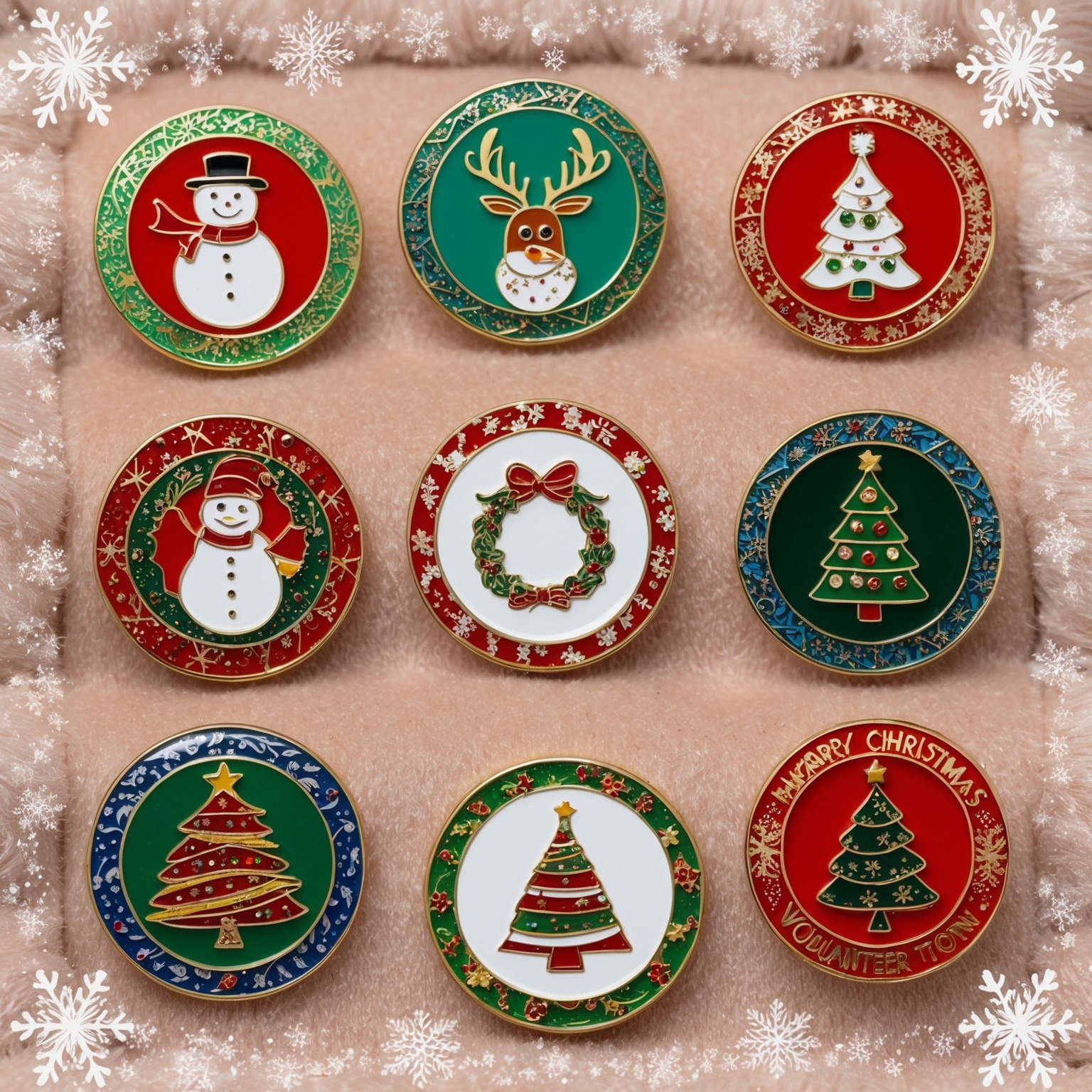Sports trading pins are more than just small pieces of metal; they are symbols of pride, passion, and unforgettable moments in sports history. For decades, these collectible items have captured the hearts of fans, players, and collectors alike, serving as tangible reminders of iconic games, teams, and athletes. Some sports trading pins have even transcended their original purpose, becoming legendary in their own right due to their rarity, historical significance, or unique design. In this article, we will explore some of the most famous sports trading pins in history, delving into their stories, what makes them so special, and why they continue to be cherished by collectors around the world.
The Origins of Sports Trading Pins
Early Beginnings
The concept of trading pins has been around for centuries, but it wasn’t until the 19th and 20th centuries that they became closely associated with sports.
- Olympic Beginnings: The tradition of trading pins began in the Olympic Games, where athletes, officials, and fans exchanged small lapel pins as symbols of friendship and goodwill. The first recorded instance of pin trading at the Olympics dates back to the 1896 Games in Athens, Greece, where athletes and officials traded small cardboard badges to commemorate their participation.
- Baseball and Early American Sports: In the United States, baseball was one of the first sports to popularize trading pins. In the early 20th century, baseball teams began producing pins featuring their logos, mascots, and players, which fans could purchase or trade as keepsakes. These early pins were often made from metal and enamel, setting the standard for future sports trading pins.
The Evolution of Sports Trading Pins
As the popularity of sports grew throughout the 20th century, so too did the practice of creating and trading sports pins. What began as a simple way to commemorate sporting events quickly evolved into a beloved hobby for millions of fans and collectors.
- Expansion to Other Sports: While baseball and the Olympics were the initial driving forces behind sports trading pins, the practice soon spread to other sports, including football, basketball, hockey, and soccer. Teams and leagues across various sports began producing their own pins, each with unique designs and themes.
- Collector’s Items: By the latter half of the 20th century, sports trading pins had become highly sought-after collector’s items. Special edition pins, limited releases, and pins commemorating significant events became particularly prized by collectors, leading to the emergence of a vibrant trading community.
The Most Famous Sports Trading Pins and Their Stories
The 1980 “Miracle on Ice” Olympic Hockey Pin
One of the most iconic moments in sports history is the “Miracle on Ice,” the 1980 Winter Olympics hockey game where the underdog U.S. team defeated the heavily favored Soviet Union. This victory is commemorated by one of the most famous Olympic trading pins.
- Design and Significance: The “Miracle on Ice” pin features the U.S. team’s logo with the date of the historic game, February 22, 1980. The pin symbolizes not just a victory in sports, but a moment of national pride during a time of political tension between the United States and the Soviet Union.
- Rarity and Value: Given the historical significance of the event, the “Miracle on Ice” pin is highly sought after by collectors. Original pins from the 1980 Olympics are rare and can fetch high prices at auctions, especially those in mint condition or with provenance linking them to participants in the event.
The 1996 Atlanta Olympics Torch Relay Pin
The 1996 Summer Olympics in Atlanta, Georgia, were marked by numerous memorable moments, including Muhammad Ali lighting the Olympic cauldron. However, one of the most iconic symbols of these Games is the Torch Relay pin.
- Design and Symbolism: The 1996 Torch Relay pin features a stylized flame with the Olympic rings and the date of the relay. It commemorates the journey of the Olympic flame as it traveled across the United States, uniting communities in the spirit of the Games.
- Collector’s Item: Torch Relay pins were produced in limited quantities, making them a coveted item for Olympic pin collectors. The pin is a reminder of the excitement and anticipation that built up as the torch made its way to Atlanta, culminating in the dramatic opening ceremony.
The 2001 New York Yankees World Series Pin
The New York Yankees are one of the most storied franchises in baseball history, and their 2001 World Series pin is a significant piece of sports memorabilia.
- Design and Impact: The 2001 Yankees World Series pin features the iconic Yankees logo alongside the American flag, a design choice reflecting the aftermath of the September 11 attacks. The pin serves as a symbol of resilience and unity, as the Yankees’ playoff run provided a source of hope and inspiration for New Yorkers and Americans during a challenging time.
- Historical Value: Although the Yankees did not win the World Series in 2001, the pin remains highly valuable due to its connection to the post-9/11 period. It is a poignant reminder of how sports can bring people together in the face of adversity.
The 1992 Dream Team Olympic Basketball Pin
The 1992 U.S. Men’s Olympic Basketball Team, known as the “Dream Team,” is widely regarded as the greatest basketball team ever assembled. The Dream Team’s trading pin is a cherished item among sports enthusiasts.
- Design and Legacy: The Dream Team pin features the USA Basketball logo and the names of the legendary players who made up the team, including Michael Jordan, Magic Johnson, and Larry Bird. The pin symbolizes the dominance of the Dream Team, which won the gold medal in Barcelona and revolutionized the global popularity of basketball.
- Collector’s Treasure: The Dream Team pin is a must-have for basketball fans and Olympic collectors alike. Its association with one of the most dominant performances in sports history adds to its allure and value.
The 1998 FIFA World Cup “Footix” Mascot Pin
The FIFA World Cup is the most prestigious tournament in international soccer, and the 1998 World Cup in France introduced one of the most beloved mascots, Footix.
- Design and Popularity: Footix, a cheerful rooster representing France’s national symbol, became an instant hit among fans. The 1998 World Cup pin featuring Footix is colorful and playful, capturing the excitement and joy of the tournament.
- Global Appeal: As soccer is the world’s most popular sport, the Footix pin is highly collectible on a global scale. It serves as a memento of France’s successful hosting of the World Cup and the tournament’s widespread appeal.
The 2004 Boston Red Sox “Reverse the Curse” Pin
The Boston Red Sox’s 2004 World Series win is one of the most dramatic and celebrated moments in baseball history, ending the team’s 86-year championship drought, often referred to as the “Curse of the Bambino.”
- Design and Symbolism: The “Reverse the Curse” pin features the Red Sox logo with the phrase “Reverse the Curse,” commemorating the team’s historic comeback against the New York Yankees in the ALCS and their subsequent World Series victory. The pin is a symbol of perseverance, hope, and the end of a long-standing curse.
- Collector’s Significance: For Red Sox fans and baseball collectors, the “Reverse the Curse” pin is a prized possession. Its significance in breaking the curse and ending the long championship drought makes it one of the most valuable and emotionally resonant pins in sports history.
The 2010 Vancouver Olympics Inukshuk Pin
The 2010 Winter Olympics in Vancouver, Canada, featured the Inukshuk as its official logo and symbol, a traditional Inuit stone landmark representing guidance and safety.
- Design and Cultural Importance: The Inukshuk pin features the iconic stone figure, which became a symbol of the 2010 Games. The pin represents not only the Olympics but also the indigenous culture of Canada and the welcoming spirit of the host nation.
- Cultural Value: The Inukshuk pin holds cultural significance beyond the realm of sports, making it a valuable item for collectors interested in Olympic history, indigenous culture, and Canadian heritage.
Why These Pins Became Legendary
Historical Significance
The most famous sports trading pins often have a deep historical connection to significant events in sports and beyond.
- Moments of Triumph and Resilience: Pins that commemorate historic victories, like the “Miracle on Ice,” or moments of resilience, like the 2001 Yankees pin, resonate with collectors because they represent more than just a game—they capture the spirit of a moment in time.
- Cultural Impact: Some pins, such as the 1998 World Cup Footix pin or the Vancouver Olympics Inukshuk pin, become legendary due to their cultural significance. These pins transcend sports and become symbols of national pride, cultural heritage, or global unity.
Rarity and Exclusivity
Rarity is a key factor in determining the value and desirability of a sports trading pin. The more exclusive and limited the pin, the more likely it is to achieve legendary status.
- Limited Editions: Pins that were produced in limited quantities or were only available for a short time, such as the Torch Relay pins or exclusive event pins, are highly sought after by collectors. Their rarity makes them valuable and desirable.
- Chase and Variant Pins: Chase pins or variant pins that feature unique designs or colors are also prized by collectors. These pins are often harder to find, making them more valuable and adding to their mystique.
Design and Aesthetics
The design of a pin plays a crucial role in its appeal. Well-designed pins that are visually striking or feature unique elements are more likely to stand out and become collectibles.
- Artistry and Craftsmanship: Pins that feature intricate designs, vibrant colors, or creative use of materials are more likely to be cherished by collectors. The artistry and craftsmanship that go into creating these pins elevate them from simple collectibles to works of art.
- Iconic Symbols and Logos: Pins that incorporate iconic symbols, such as the Olympic rings, team logos, or mascots, are more likely to become legendary. These symbols are instantly recognizable and hold significant meaning for fans and collectors.
Emotional and Sentimental Value
For many collectors, the emotional and sentimental value of a pin is just as important as its historical significance or rarity.
- Personal Connections: Pins that are associated with personal memories, such as attending a historic game or participating in a significant event, hold deep emotional value. Collectors often cherish these pins as reminders of special moments in their lives.
- Community and Identity: Sports trading pins also represent a sense of community and identity. Whether it’s a pin from a favorite team, a local sports event, or a global competition like the Olympics, these pins connect collectors to a larger community of fans and enthusiasts.
Tips for Collecting and Preserving Famous Sports Trading Pins
Building a Collection of Legendary Pins
If you’re interested in building a collection of famous sports trading pins, here are some tips to get you started:
Research and Education
- Learn the History: Understanding the history and significance of famous sports trading pins is essential for building a valuable collection. Research the events, teams, and athletes associated with the pins you’re interested in, and familiarize yourself with their stories.
- Stay Informed: Keep up with trends and news in the world of sports trading pins. Join online forums, attend pin trading events, and connect with other collectors to stay informed about new releases, rare finds, and market trends.
Focus on Quality and Condition
- Prioritize Condition: The condition of a pin is one of the most important factors in determining its value. Look for pins that are in mint or near-mint condition, with no visible damage, scratches, or discoloration.
- Verify Authenticity: Be cautious of counterfeit or replica pins. Verify the authenticity of a pin before purchasing it, especially if it’s a rare or valuable item. Look for official markings, serial numbers, or certificates of authenticity.
Start with a Theme
- Choose a Focus: Building a collection around a specific theme, such as Olympic pins, World Series pins, or pins from a favorite team, can make your collection more cohesive and meaningful.
- Expand Over Time: As you become more experienced and knowledgeable, consider expanding your collection to include pins from different sports, events, or historical periods.
Preserving the Value of Your Collection
Once you’ve built your collection of famous sports trading pins, it’s important to take steps to preserve their value.
Proper Storage and Handling
- Use Protective Storage: Store your pins in protective cases, albums, or boxes to prevent damage from dust, dirt, and moisture. Consider using anti-tarnish strips or silica gel packets to protect metal pins from tarnish and corrosion.
- Handle with Care: Always handle your pins with clean hands or gloves to avoid transferring oils and dirt. Minimize direct contact with the pins to prevent scratches or other damage.
Regular Cleaning and Maintenance
- Gentle Cleaning: Clean your pins regularly using soft brushes or microfiber cloths to remove dust and dirt. Avoid using harsh chemicals or abrasive materials that could damage the pin’s surface.
- Inspect for Damage: Periodically inspect your pins for signs of wear, tarnish, or damage. Address any issues promptly to prevent further deterioration.
Insurance and Documentation
- Insure Your Collection: If your collection includes valuable or rare pins, consider purchasing insurance to protect your investment. Keep detailed records of your collection, including photographs, descriptions, and appraisals, to facilitate the insurance process.
- Document Provenance: For pins with historical significance, document their provenance and history. This information can enhance the value of your collection and provide important context for future collectors.
Conclusion
Sports trading pins are more than just collectibles; they are pieces of history that capture the essence of unforgettable moments in sports. From the “Miracle on Ice” to the “Reverse the Curse,” these pins have become legendary symbols of triumph, resilience, and pride. Whether you’re a seasoned collector or new to the world of pin trading, understanding the stories and significance behind these famous pins can deepen your appreciation for the hobby and help you build a valuable and meaningful collection.
As you embark on your journey to collect and preserve sports trading pins, remember that each pin represents more than just a game or event. It is a connection to a shared history, a community of fans, and the enduring spirit of sports. By taking the time to research, collect, and care for your pins, you can ensure that they remain cherished treasures for generations to come.
If you are interested in buying high quality custom trading pins, you can call us at 1-800-641-1299 or fill out a FREE quote form.







